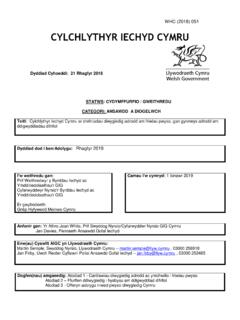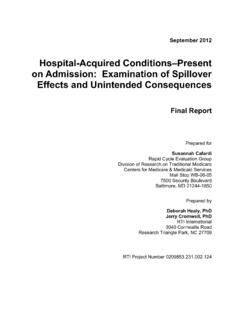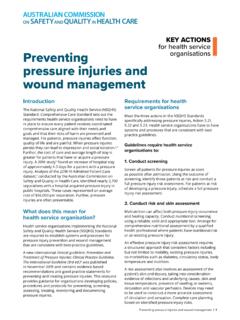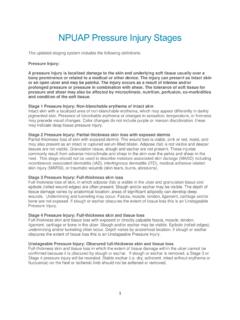Transcription of Key Performance Indicators for Hospital Reporting ...
1 Key Performance Indicators 1 Key Performance Indicators for Hospital Reporting Citation Garrubba M, Joseph C, Melder A, Yap G. 2016. Key Performance Indicators for Hospital Reporting : A Rapid Review. Centre for Clinical Effectiveness, Monash Health, Melbourne, Australia. Executive Summary The Centre for Clinical Effectiveness (CCE) was asked to report on Indicators that demonstrate a high performing Hospital . To do so, we identified the most common and current reported domains and Indicators of Performance in healthcare. Preliminary searches identified a 2013 report produced by the Australian Institute of Health Innovation (AIHI), University of NSW1 which examined Performance Indicators used nationally and internationally to report publically on the Performance of healthcare organisations and local health systems.
2 This report was updated and results reported here include the AIHI1 and publications from 2013 onwards. For each report identified, information was extracted regarding domains and Indicators . To identify the most current and frequently reported Indicators , comparisons were made across each report identified. Where a minimum of three studies reported the same indicator, the indicator was selected as one that is considered important to measure for Performance . These were then compared against the current set of Indicators measured by Monash Health. The literature highlighted key sets of Indicators (reported by the greatest number of sources) and were categorised under the most commonly reported domains: Domain Indicators Safety and Effectiveness Mortality, unplanned Hospital readmission, Hospital acquired infections, safety of maternity services and cancer Equity and Access Emergency Department (ED) wait length, specialist care wait length Efficiency/Value for money Cost and length of stay Patient Centered/Experience Maternity and in-patient personal needs The series of tables below (1a-d) show that there are a number of domains and Indicators in the literature that are common with Monash Health.
3 Indicators highlighted green show similarities between the literature and Monash Health. Indicators highlighted orange show additional/different Indicators measured by Monash Health compared to what is reported in the literature. Indicators highlighted red have been reported in the literature and not by Monash Health. Indicators highlighted yellow are marked as Performance priorities in the 2015-2016 Monash Health Statement of Priorities list. This review has identified the most common and current reported domains and Indicators of Performance in healthcare and compared them to those measured by Monash Health. Similarities between domains and Indicators between Monash Health and the literature were generally seen in Safety and Effectiveness and Patient Centered/Experience.
4 Rapid Review Key Performance Indicators 2 Table 1a. Safety and Effectiveness: domains and Indicators Indicators (from literature) Monash Health Indicators Domain: Safety and Effectiveness Similar Indicators Additional/Different Indicators In- Hospital mortality rates In- Hospital mortality rates Ischaemic stroke and myocardial infarction2-4 In- Hospital mortality rates of fractured neck of femur3-4 In- Hospital mortality rates Pneumonia 3-4 Hospital -standardised mortality ratios4 Hospital 30 day mortality Deaths in low mortality diagnosis related groups (headache, hand procedures, arthroscopy)4 Deaths from VTE events5 % Low mortality Diagnosis Related Group (DRG) admissions resulting in in- Hospital mortality % Acute Myocardial Infarction (AMI)
5 Admissions resulting in in- Hospital mortality % Fractured neck of femur admissions resulting in in- Hospital mortality % Pneumonia admissions resulting in in- Hospital mortality Hospital Standardised Mortality Ratio (HSMR) Rate of preventable Hospital acquired DVT/PE per 1,000 separations % Heart failure admissions resulting in in- Hospital mortality % Stroke admissions resulting in in- Hospital mortality Percentage deaths coded but not recorded in Victorian Health Incident Management System (VHIMS) death module Percentage deaths classifications confirmed within 60 days Number of preventable deaths per month Number of death rate of outliers versus inliers Infant mortality deaths per 100 live births6 Unplanned Hospital re-admission 30 day Hospital readmission 5-6 Unplanned Hospital readmission rates for patients discharged following management of.
6 Acute myocardial infarction, heart failure, knee replacements, schizophrenia, paediatric tonsillectomy and adenoidectomy 3-4 % Acute Myocardial Infarction (AMI) unplanned re-admission within 30 days % Heart failure unplanned re-admissions within 30 days % Paediatric tonsillectomy/adenoidectomy unplanned re-admissions within 15 days % Knee replacement unplanned re-admissions within 60 days % Hip replacement unplanned re-admissions within 60 days % Depression unplanned re-admissions within 28 days % Schizophrenia unplanned re-admissions within 28 days % HITH unplanned re-admissions within 28 days Unplanned Hospital readmission rates for patients discharged following management of: depression Emergency readmissions within 30 days of discharge from hospital5-6 The rate of readmission for heart failure patients, pneumonia patients, hip and knee replacement patients have been identified as important indicators1 Key Performance Indicators 3 Indicators (from literature) Monash Health Indicators Domain.
7 Safety and Effectiveness Similar Indicators Additional/Different Indicators Hospital associated infection Sepsis following abdominal surgery2 Incidence of healthcare-associated staphylococcus aureus bacteraemia including Methicillin-resistant Staphylococcus aureus (MRSA) 1,3,6 Incidence of healthcare-associated infection1,5 The percentage of patients with a Hospital acquired infection1 Rate of sepsis per 1,000 bed days Rate of Hospital acquired sepsis per 1,000 bed days VICNISS - Hospital acquired infection (Overall) Rate of Hospital acquired Staph. Aureus Bacteraemia Rate of Clostridium difficile Rate (plus raw number) of Hospital acquired severe sepsis and septic shock per month Rate (plus raw number) of deaths in patients with Hospital acquired severe sepsis and septic shock per month Number of Hospital acquired sepsis of outliers versus inliers Dandenong Hospital colorectal surgery deep surgical site infection (SSI) Dandenong Hospital colorectal surgery superficial surgical site infection (SSI) All Dandenong Hospital colorectal surgery surgical site infection (SSI) Monash Health cardiothoracic surgery deep surgical site infection (SSI) Monash Health cardiothoracic surgery superficial surgical site infection (SSI) All Monash Health cardiothoracic surgical site infection (SSI)
8 Number of patients with surgical site infections Rate of patients with postoperative wound dehiscence Rate of patients with postoperative wound haemorrhage Central line associated bloodstream infections (ICU) - Dandenong Hospital Central line associated bloodstream infections (ICU) - Monash Medical Centre Hand hygiene statistics1 The percentage of occasions central line bundle1 Discharges with central venous catheter placement with associated bloodstream infections1 Catheter- associated urinary tract infection1 Hospitalisati-on Patients hospitalised with an ischaemic cardiovascular (CVD) event (myocardial infarction, ischaemic stroke and/or coronary or peripheral arterial procedure) who have receive triple therapy (statin, a blood pressure -lowering medicine, an antiplatelet or anticoagulant medicine)1, Hospitalisations for congestive heart failure, asthma, chronic obstructive pulmonary disease, and diabetes complications2 The percent of patients hospitalised with heart No MH Indicators measured Key Performance Indicators 4 Indicators (from literature) Monash Health Indicators Domain.
9 Safety and Effectiveness Similar Indicators Additional/Different Indicators failure who received recommended care has also been measured1 Emergency admissions for acute conditions that should not usually require Hospital admission5 Mental Health The proportion of hospitalised patients with schizophrenia assessed for suicide risk at discharge1 The proportion of hospitalized patients with depression assessed for suicide risk at discharge1 The proportion of hospitalized patients with depression discharged with a planned follow-up1 Suicide deaths per 100,000 population6 Number of reportable Mental Health deaths Percentage of adult Mental Health patients who have post discharge follow-up within 7 days Percentage of child and adolescent Mental Health patients with post-discharge follow-up within seven days Percentage of aged Mental Health patients who have post-discharge follow up within seven days Rate of mechanical restraint per 1,000 bed days Rate of seclusion exceeding 4 hours - Adult only Rate of seclusion per 1,000 bed days Percentage of Seclusion events relating to an acute admission (composite seclusion rate)
10 Rate of seclusion events relating to an adult acute admission Rate of seclusion events relating to a child and adolescent acute admission Rate of seclusion events relating to an aged acute admission Number of inpatient absconds Number of inpatients absent without leave Key Performance Indicators 5 Indicators (from literature) Monash Health Indicators Domain: Safety and Effectiveness Similar Indicators Additional/Different Indicators (AWOL) Number of intentional self-harm Number of reportable Mental Health deaths 28 day re-admission rate - Adult only Post-operative VTE Serious blood clots after surgery1 Post-operative venous thromboembolism following hip/knee surgery2 No MH Indicators measured Harm The incidence of medication errors causing serious harm1 Safety incidents involving severe harm or death1 Deaths attributable to problems in healthcare5-6 Severe harm attributable to problems in healthcare5 Number of Incident Severity Rating (ISR) 1 & 2 rated medication errors.












